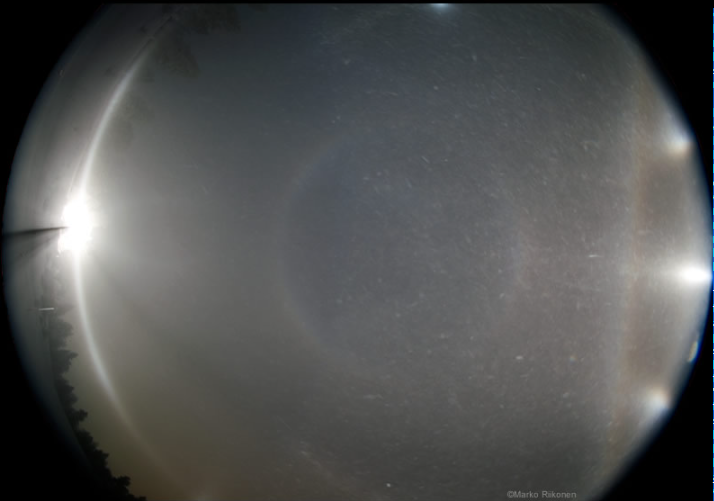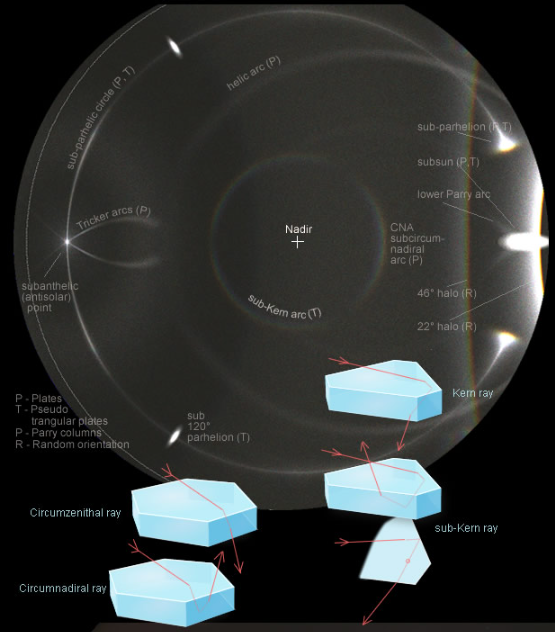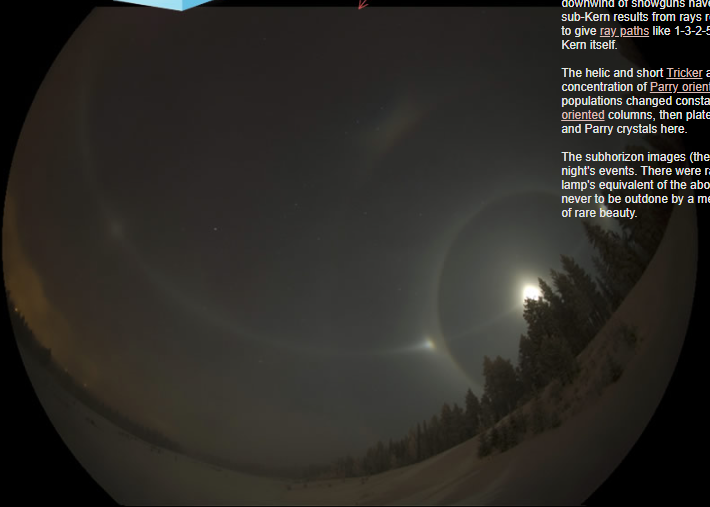More New Halos
More New Halos: A Spectacular Display of Atmospheric Optics in Rovaniemi, Finland
In the realm of atmospheric optics, Rovaniemi, Finland has established itself as a true halo land. On the night of December 7, 2008, halo expert Marko Riikonen captured a breathtaking spectacle in the sky above Rovaniemi - a display of hitherto unseen halos. The images he captured that night have opened up new avenues for analysis and exploration in the field.
Previously, on the night of November 5th, Marko had already demonstrated the potential for capturing magnificent halos in Rovaniemi. Using a 150W halogen lamp to illuminate high-quality crystals formed downwind of ski-slope snow machines, he had obtained stunning results. However, it was on the following morning, when the sun banished the lamp, that a new halo emerged. And now, Marko has discovered even more new arcs.
The fisheye image he captured is a composition of two 30-second exposures. What makes these arcs truly remarkable is that they are subhorizon halos, paradoxically visible against the night sky. By positioning the camera below the lamp and pointing it upwards at the zenith, Marko managed to invert the "halo sky" created by the lamp, revealing the subhorizon arcs suspended in the heavens. Typically, subhorizon halos generated by the sun are challenging to study because they can only be observed from specific vantage points like aircraft or ski slopes, or when nearby diamond dust glimmers against a dark background.
Now let's delve into the specifics of these new halos captured by Marko Riikonen. To better understand their characteristics, we can refer to the HaloSim ray tracing simulation as a preliminary guide. However, it's important to note that Marko's Sunday evening pictures provide a wealth of material for in-depth analysis, and this initial examination is merely scratching the surface.
In one of the images, we can observe a bright subsun (or sublamp) flanked by two subparhelia - below-horizon halos that are often seen from aircraft. To the left, we also notice the subparhelic circle, which shines brightly in the antisolar (subanthelic) direction and is sharper than the parhelic circle. Additionally, a colorful 46-degree halo traverses the image, adding to the celestial spectacle.
Moving on to the new halos, we encounter a sub-120° parhelion at the lower edge of the frame. This parhelion, never before imaged, serves as the subhorizon counterpart of the 120-degree parhelion. It is a remarkable discovery that expands our understanding of these atmospheric phenomena.
At the center of the image, our gaze effectively points straight downwards towards the nadir. Here, we find a colored arc to the right, which represents the subhorizon equivalent of the familiar circumzenithal arc. We can refer to this as a "circumnadiral" arc - a sighting that is likely unprecedented. This discovery adds another layer of complexity to our comprehension of atmospheric optics.
However, the most astonishing revelation lies in the complete circle surrounding the nadir, appearing brighter in certain sections. This is known as a sub-Kern arc, and its counterpart - the Kern arc - was only captured a year ago, once again in Finland by Marko Mikkilä. Now, with the discovery of its nadiral counterpart, we are witnessing a truly rare phenomenon.
Among the other arcs captured by Marko Riikonen is the helic (or heliac) arc, which streams away from the lamp across the subsky. This arc, along with the short Tricker arcs, originates from a low concentration of Parry oriented column crystals. It is fascinating to observe how the crystal populations evolved throughout the night, transitioning from singly oriented columns to plates, and finally culminating in a mixture of plates and Parry crystals.
The images of the subhorizon halos, which are just a fraction of the events that unfolded that night, are accompanied by an array of rare arcs scattered across the lamp's equivalent of the above-horizon sky. Even the Moon, in its own celestial grandeur, cast its own halos of exquisite beauty.
The discoveries made by Marko Riikonen on that eventful night in Rovaniemi, Finland have expanded our knowledge of atmospheric optics. The images captured and the subsequent analysis provide valuable insights into the formation and behavior of these mesmerizing phenomena. As we continue to unravel the complexities of our atmosphere, the study of halos and other atmospheric optics will undoubtedly captivate our imagination and deepen our appreciation for the wonders of the natural world.

Christmas arrived early in Rovaniemi, Finland. On Sunday night Dec 7, '08 halo expert Marko Riikonen (site) imaged a spectacular skyfull of hitherto unseen halos.
Finland is halo land and its capital must now be Rovaniemi. Earlier there, at on the night of Nov 5th, Marko used a 150W halogen lamp to light high quality crystals formed downwind of ski-slope snow machines. He obtained magnificent halos (1,2). Next morning the sun banished the lamp to show a new halo. Now Marko has more new arcs.
The fisheye image is a stack of two 30s exposures. The arcs are subhorizon halos seen paradoxically against the night sky. The camera was below the lamp and pointing upwards at the zenith. This turned the lamp 'halo sky' upside down so that the subhorizon arcs were in the sky. Sun generated subhorizon halos are difficult to study because they are only visible looking downwards from aircraft, ski-slopes or as nearby diamond dust glints against dark ground.

Where do we start! Use the HaloSim ray tracing for orientation. The simulation is preliminary because Marko's Sunday evening pictures provide material for long analysis and this is just a first look.
At right is a bright subsun (sublamp!) flanked by two subparhelia. These are the below horizon halos most often seen from aircraft. The subparhelic circle bright in the antisolar (subanthelic) direction at left is also seen from the air and is actually sharper than the parhelic circle. At right a colourful 46-degree halo courses across the image.
Now for the new halos. Just on the frame's lower edge is a sub-120° parhelion, never before imaged and the subhorizon counterpart of the 120 degree parhelion.
At center we are effectively looking straight downwards towards the nadir. The coloured arc to its right is the subhorizon equivalent of our familiar circumzenithal arc - a 'circumnadiral' arc. The CNA has probably never been seen before.
But the real shock is the complete circle, brighter in parts, around the nadir. This is a sub-Kern arc. The extremely rare Kern arc around the zenith was itself only imaged a year ago (again in Finland, that time by Marko Mikkil�). Now we have its nadiral counterpart.
Another arc is the helic (or heliac), streaming away from the lamp across the subsky.
Plate crystals produced most of the display. Regular hexagonal plates could have made the CNA. Subhorizon arcs result when there is one (or more) internal reflection from the big lower faces of plates. To make the CNA, downward going rays entering the crystal top face are internally reflected back upwards before leaving a vertical side face.
The subKern, like the Kern, requires either improbably thick plates or ones tending to a triangular shape i.e. hexagons with alternate sides long and short. Many crystals formed downwind of snowguns have a quasi-triangular habit. The sub-Kern results from rays reflected off the lower face (.2) to give ray paths like 1-3-2-5 compared to the 1-3-5 for the Kern itself.
The helic and short Tricker arcs come from a low concentration of Parry oriented column crystals. The crystal populations changed constantly, earlier there were singly oriented columns, then plates and then the mixture of plates and Parry crystals here.
The subhorizon images (there are more) are only part of the night's events. There were rare arcs strewn also across the lamp's equivalent of the above-horizon sky. And the Moon, never to be outdone by a mere light-bulb, cast its own halos of rare beauty.

Note: this article has been automatically converted from the old site and may not appear as intended. You can find the original article here.
Reference Atmospheric Optics
If you use any of the definitions, information, or data presented on Atmospheric Optics, please copy the link or reference below to properly credit us as the reference source. Thank you!
-
<a href="https://atoptics.co.uk/blog/more-new-halos/">More New Halos</a>
-
"More New Halos". Atmospheric Optics. Accessed on April 25, 2024. https://atoptics.co.uk/blog/more-new-halos/.
-
"More New Halos". Atmospheric Optics, https://atoptics.co.uk/blog/more-new-halos/. Accessed 25 April, 2024
-
More New Halos. Atmospheric Optics. Retrieved from https://atoptics.co.uk/blog/more-new-halos/.